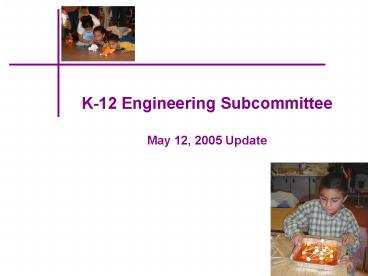K-12 Engineering Subcommittee - PowerPoint PPT Presentation
Title:
K-12 Engineering Subcommittee
Description:
Title: Slide 1 Author: tempuser Last modified by: sully Created Date: 5/9/2005 9:07:04 PM Document presentation format: On-screen Show Company: University of Colorado – PowerPoint PPT presentation
Number of Views:80
Avg rating:3.0/5.0
Title: K-12 Engineering Subcommittee
1
- K-12 Engineering Subcommittee
- May 12, 2005 Update
2
Subcommittee Members
- Janie Fouke Michigan State University
- Pat Galloway Nielsen-Wurster Grp/ASCE
- Gary May GA Inst. of Technology
- Susan Metz Stevens Inst. Technology
- Rick Miller Olin College of Engineering
- Jackie Sullivan Univ. Colorado Boulder
- Assisted by NSF Staff
- Sue Kemnitzer
- Mary Poats
3
The Motivation
- Science and math performance of our nations
youth - Flat and declining engineering enrollments
- Women minority students conspicuously
under-represented - Public perception of engineers / engineering/
technology sad - Preparing youth for change in a complex world
4
Science Engineering Degrees
U.S.
Asia
Asia China, India, Japan, South Korea and
Taiwan. Natural science math, physics,
chemistry, astronomy, biological, and earth,
atmospheric, ocean, agricultural sciences and
computer sciences. Source Science Engineering
Indicators, 2002
5
BS Engineering Degrees - 2003
- Degrees by Ethnicity Gender
- Women 20.4
- African American 5.1
- Hispanic 5.4
All lower than 1999!
African Americans, Latinosand Native Americans
comprise 30 of college-age people, and 25 of
the U.S. workforce
Source ASEE PRISM, September 2004
6
K-12 Subcommittee Charge
- Summarize ENG 00-05 investment in K-12
engineering - Evaluate effectiveness of various NSF or ENG K-12
engineering program features - Decipher which elements show promise and may
merit further investment - Ascertain initiatives that harvest ENG K-12
investments and trulydisseminate results
7
K-12 Subcommittee Charge
- Evaluate if NSF-funded K-12 engineering
initiatives support the reality of the
standards-based K-12 world - Recognizing the K-Grey continuum, recommend if
programs should be better linked to encourage
student participation
8
K-12 Subcommittee Charge
- Evaluate if smaller ERC-like programs should be
developed to bridge between programs at an
institution - Determine if ENG has aK-12 investment plan
- If so, evaluate and react to it
- Make recommendations to ENG re K-12 investment
9
Key K-12 Questions
- Considering the challenge with engineering
enrollments, should ENG respond (and not rely on
EHR or Dept of Ed)? - Should ENG invest in K-12 initiatives?
- If yes, designed to achieve what goals?
- What can be gained by K-12 engineering
initiatives when the public message about
engineering is not invitingto youth?
10
Key K-12 Questions
- If ENG should invest in K-12, what of the
budget should be allocated to this priority? - Should AP engineering courses be created that
focus on working togetherto create things for
the benefit of society?(pedagogy is key) - Should initiatives be funded to disseminate
whats already been created?
11
K-12 Subcommittee Plan
- Synthesize recommendations in these reports as
they relate to K-12 engineering - Engineer 2020 (NAE)
- Assessing the Capacity of the U.S. Engineering
Research Enterprise (NAE) - Innovate America National Innovation Initiative
- Strategic Directions for Engineering Research,
Innovation Education (NSF) - Extraordinary Women Engineers (ASCE)
- Building Engineering and Science Talent in K-12
(BEST)
12
K-12 Subcommittee Plan
- Evaluate ENG initiatives that invest in K-12
- Effective?
- Why or why not?
- Worth expanding? Changing?
- Focus on dissemination of whats already been
created - Be driven by realities of standards-based K-12
world - Preliminary recommendations Nov 05 final report
January 2006
13
Summarize ENG K-12 Investment
- ENG Directorate (39M and counting)
- GK-12 11.3M (00-05)
- RET 13.7M (incl. 2.5 M supplements 01-05)
- Bridges for Engineering Education 9M (02-04)
- Nanotech Cntr for Learning Teaching (NCLT) 5M
(04-08) - NSDL 8 engineering-related projects (no ENG
contribution to date)
14
Creating Tomorrows Engineers
- The challenge is great
- so are the opportunities!
15
Last Thought
It is our choices, Harry Potter, that show what
we truly are,far more than our abilities.
--- Professor Dumbledore, Headmaster
Hogwarts School for Witchcraft and Wizardry
16
Feedback?
- Suggestions?
17
Title
18
What Do Engineers Do?
2003 1998
Build/construct/make things 38 26
Design/draw/plan 19 27
Mechanic/mechanical work 9 2
Train operator 7 5
Create/are creative 3 3
Mathematics/physics 3 2
Develop new technologies 3 -
Application of technology 2 -
Work with computers 2 -
Source Harris Poll, December 2003
19
- TeachEngineering Digital Library
- Hands-on engineering curricula for grades 3-12
- Web-enabled
- Standards-based
- Searchable
- Dynamic
- Consistent look and feel
- See teachengineering.com
Search example Find engineering lessons about
the laws of motion that address national science
standard 2 for 5th grade
Engineering as a vehicle to integrate math and
science through inquiry-basedK-12 curricula and
hands-on activities relevant to the lives of
youth































